Frustration is a fun Rummy type game in which players attempt to complete 10 specific melding requirements over the course of multiple hands during the game. This game appears to actually be derived from another similar, but lesser-known game, Garbage Rummy,
which is described further below. Most games of this particular type appear to be related to the Contract Rummy family of melding games. During the course of the game,
each player attempts to fulfill each of 10 requirements during individual hands during play, which is probably how the game got the name Frustration.
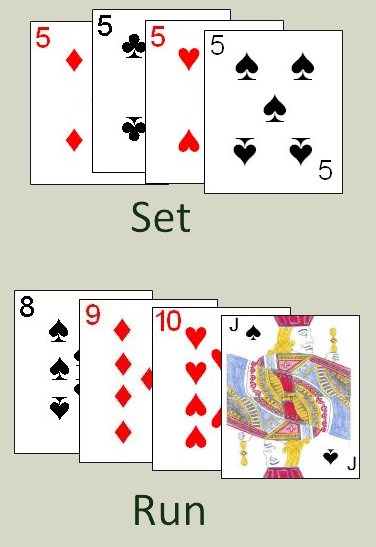
The standard game Frustration is designed to be played by 2 to 5 players, but variants for more players are
described below. The game uses two standard 52 card decks shuffled together. For the best play experience the decks should be of the same back design, but this is not absolutely essential. The sequential ranking of the cards in this game are as follows, from high to low; Ace, King, Queen, Jack, 10, 9, 8, 7, 6, 5, 4, 3. All two's are wild cards and can be used as a replacement for any other card in creating a meld.
Determination of seating positions and first dealer can be performed in a number of ways, with draw for high cards the most common. The players would each draw a card from the shuffled deck, and would take seats at the table, based on the rank of the cards draw, from highest to lowest. If two or more player draw cards of the same rank, those players would redraw until drawing cards of a unique denomination. The player drawing the highest card of all would become the first
dealer. Thereafter, the deal would rotate around the table in a clockwise rotation from player to player.
Once the dealer has been determined and the players seated, the dealer should thoroughly shuffle the deck and offer it to the player at his immediate right to cut. After the cut, the dealer then deals the cards, face-down and one at a time in a clockwise direction around the table, starting with the player to his immediate left. He continues dealing around the table until each player has 11 total cards. The dealer then places the remainder of the deck in a pile face-down in the center of the table to make the draw pile. Lastly, he flips over the top card of the draw pile, laying it face-up next to the draw pile to start the discard pile.
The goal of each player is to make each of the 10 required melds during the course of 10 or more hands. Thus, at the start of the game, each player attempts to fulfill the requirement of the first meld. Once able to complete this meld (on the first hand, or a later one) he may then advance to attempting to make the next meld in the series
on a subsequent hand. The first player to complete all 10 melds over the
course of multiple hands, wins the game upon completion of that tenth melding
requirement. The meld types in this game are as follows:
- Set: A set consists of three or more cards of the exact same denomination (i.e. four fives).
- Run: A run is a series of four or more sequential cards. Dissimilar to most other Rummy type games, in Frustration, the cards in a sequence can be of any suit, as long as they are in direct sequential order.
A specific meld may never contain more wild cards (twos) than non-wild cards. Although this
descriptions of sets and runs show the basic requirements for a set or run, to fulfill the specific requirement for a hand, these sets or runs may require fewer or more cards, as per the chart below for a specific meld order. The lowest card allowed in a meld is a 3 and the highest card an Ace.
The 10 requirements a player must fulfill, and the order in whicn these requirements must be fulfilled, are as follows:
|
|
|
| Requirement Order | Meld |
|---|
| 1 | 2 sets of three cards |
| 2 | 1 run of four cards and 1 set of three cards |
| 3 | 1 run of seven cards |
| 4 | 1 sets of five cards and 1 set of three cards |
| 5 | 1 run of four cards and 1 set of four cards |
| 6 | 2 sets of four cards |
| 7 | 1 run of eight cards |
| 8 | 1 set of five cards and another set of two cards |
| 9 | 1 run of nine cards |
| 10 | 1 set of five cards and another set of five cards |
|
|
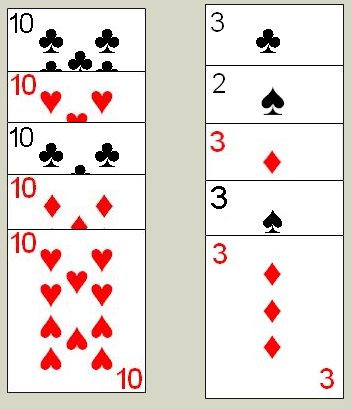
|
At the start of a game, every player will be attempting to fulfill the requirements of the first meld (2 sets of three cards). However, as the game progresses, players will attempt to complete this meld and progress through each of these melds in order. Only one
of these specific meld types may be completed on an individual hand and the melds must be completed in this order over the course of 10 or more hands.
It should be noted, that although, during a player's eighth contract, part of that required contract is a set of two of two cards (a pair of cards of equal rank), this is not a legal meld at any other time during the game.
A player may not make any melds to the table until he has completed his current meld requirement. Once he is able to make the required meld, he may then lay down all these melds. In addition, he may lay down any additional melds, extend other players melds on the table or extend his starting melds with cards from his hand. On subsequent turns that player may then make any new melds or extend other melds already on the table (either his own or on any other players' melds that might be on the table).
The player to the immediate left of the dealer has the first turn and the turns continue in a
clockwise rotation around the table. On each turn, a player performs the following, in order:
- Draw:
To begin his turn, a player will draw a card. This can either be the top face-up card from the discard pile, or the top face-down card in the draw pile.
- Melds:
After drawing, a player may then meld if able to (and willing). As indicated previously, a player may meld no cards from his hand to the table until he has fulfilled his current meld requirement and played it to the table.
- Discard:
After a player makes any melds, he then discards one card to the top of the discard pile.
If the draw pile is depleted during the hand, the dealer should shuffle all but the top card of the discard pile and place them in a face-down pile to start a new draw pile.
If a player reduces his hand to exactly one card, he must knock on the table. This is an indicator to the other players that they may want to discard or play any high point scoring cards from the hand.
Once any player plays 10 cards to the table and then discards to end his turn, the hand immediately ends. Any player who was able to fulfill and play to the table his current meld requirement is permitted to move to the next meld in the order of melds. Players who are unable to fulfill the requirement must again attempt to fulfill that same requirement. The first player to have completed all 10 melds in order during the game is declared the game winner.
Jokers: Some players prefer to add two or four Jokers to the deck used to play this game. A Joker is identical to a two and can be used, at the players option, as a replacement to any other standard card in a meld. As in the standard game, no meld may contain more wild cards than non-wild cards.
More Players: Frustration can also be played quite well with additional players. To
accommodate 6, 7, or 8 players a third deck should be added (along with two more Jokers) to the deck used for the game. In all other respects, this version is played identically to the standard game as described above.
Frustration Rummy: A similar game, played under the name Frustration Rummy is also sometimes played, using very similar rules. The main differences are in regards to the cards comprising a set and the specific type and ordering of the meld requirements, but there are several other differences as well (all described below).
The first difference as mentioned, is what specifically is required for a run. In this variation, which is closer to the requirements in most other versions of Rummy, is that the cards in the sequence must all be of the exact same suit.
Frustration Rummy is designed for 2 to 5 players and the deck used to play the game consists of two standard 52 card decks along with 4 Jokers, all shuffled together.
In this game, each player receives 13 total cards.
An Ace can be considered as high or low cards in a meld, thus occurring before the 3 in a low meld or at the high end of a meld after the King.
A total of 14 meld requirements must be created in order to win the game. Only one meld requirement may be made on a specific hand, and the melds must be made in the indicated specific order. The following chart lists the meld requirements and the order they must be made by the players:
| Requirement Order | Meld |
|---|
| 1 | 3 sets of three cards |
| 2 | 1 run of four cards and 1 set of three cards |
| 3 | 1 run of four cards and 2 sets of three cards |
| 4 | 2 sets of four cards |
| 5 | 2 runs of four cards |
| 6 | 4 sets of three cards |
| 7 | 1 run of seven cards and 1 set of three cards |
| 8 | 3 sets of four cards |
| 9 | 3 runs of four cards |
| 10 | 2 sets of five cards |
| 11 | 2 runs of five cards |
| 12 | 2 sets of four cards and 1 run of four cards |
| 13 | 2 runs of four cards and 1 set of four cards |
| 14 | 1 run of nine cards and 1 set of 3 cards |
|
|
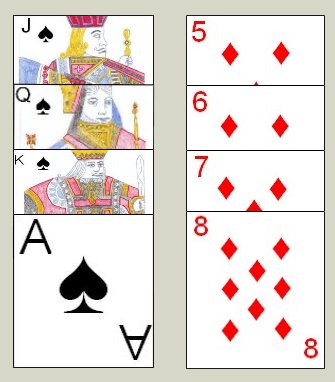
|
In all other aspects Frustration Rummy is played identically to the standard version of Frustration detailed at the top of the page.
Aggravation Rummy: Aggravation Rummy (sometimes just called "Aggravation") is another similar Rummy type game with this same concept
as in Frustration. In this variant each player attempts to work through a number (in this game, seven) different contracts over the course of a game. Once a player manages to fulfill a specific contract during a specific hand, he may then move on to the next such contract on the next deal.
Aggravation Rummy is designed for play by three to seven players, and is played using a deck created by shuffling two standard 52 card decks together and adding four total Jokers. The ranking of the cards in the deck is the same as per the game Frustration.
The game is played similar to the parent game, Frustration, with the following differences:
-
The specific menu and sequence of required contracts is shorter (only seven such required contracts are featured in Aggravation Rummy) and the specific required melds are somewhat different. The following chart shows the specific meld requirements that a player must fulfill, over the course of multiple rounds, in order to become the winner of the game:
| Requirement Order | Meld |
|---|
| 1 | 3 sets of three cards |
| 2 | 1 set of three card and 1 run of four cards |
| 3 | 2 sets of four cards |
| 4 | 2 runs of four cards |
| 5 | 1 set of four cards and 1 run of four cards |
| 6 | 4 sets of three cards |
| 7 | 1 set of three cards and 1 run of seven cards |
- As this game also includes Jokers, all twos and Jokers in the deck are considered wild cards in this game. Thus a two or Joker can be used to substitute for any other card in the deck in a run or set. However, any initial meld to the table may not contain more wild cards than natural cards in that meld. If there is any doubt, in playing a wild card with a meld,
as to what that wild card is intended to represent, the player should specify exactly what cards any wild cards are intended to replace in that meld.
- A player may only draw from the face-up discard pile on his turn if he can immediately use that card in a meld (and must thus play that card). This can be either to create a meld to lay to the table, including the players first, initial meld (which thus must fulfill the current required contract that player is striving to achieve), or play to an existing meld on the table. This is called "buy a card". However, if a player elects, on his turn, to so buy the card, he must take
not only the top card of the discard pile into his hand but rather the
entire discard pile (including that top card).
- Once a player manages to play or discard his last card during a hand
(and his melds during that hand must include the current meld requirement for that player for the round), that hand immediately ends, with that player subtracting 25 points from his current score. However, the first player to have completed all seven contracts is entitled to subtract 200 points from his overall score,
for being the first player to have achieved this.Once this occurs, the game immediately ends.
- Once a player on any hand, is able to play (or discard) his last card, that hand ends and each other player must add to his current score a number of points based on the cards remaining in the hand:
| Card Remaining in the Hand | Point Value |
|---|
| Ace | 15 Points Each |
| 10, Jack, Queen, King | 10 Points Each |
| 3, 4, 5, 6, 7, 8, 9 | 5 Points Each |
| Wild Cards (2, Joker) | 25 Points Each |
|
|
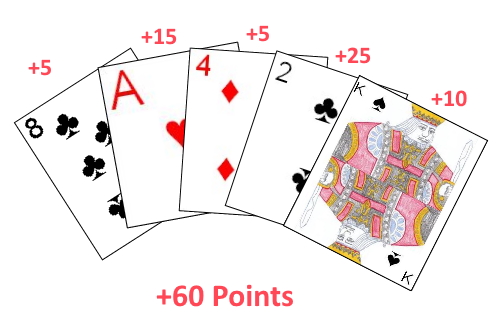
|
Each player keeps an ongoing, cumulative score during the course of the entire game.
- Once one player manages to complete all seven of the meld requirements, over the course of multiple hands
(seven or more), the game immediately ends. The player with the lowest cumulative score over the course of the entire game is declared the winner.
Other than these differences, Aggravation Rummy is in all other respects played identically to Frustration.
Twelve Step Rummy: Twelve Step Rummy is another game in which the players attempt to be the first to fulfill all the requirement contracts. In this particular variant, there are 12 contracts the players must fulfill, giving rise to the game's name.
In all aspects this game is the same as Frustration Rummy, with the difference being that there are 12 meld requirements in this version (vice
the 14 in Frustration Rummy). The 12 melds which must be completed in
specific order, are the following:
| Requirement Order | Meld |
|---|
| 1 | 2 sets of three cards |
| 2 | 1 set of three cards and 1 run of four cards |
| 3 | 2 sets of four cards |
| 4 | 2 runs of four cards |
| 5 | 3 sets of three cards |
| 6 | 1 set of four cards and 1 run of four cards |
| 7 | 1 set of three cards and 1 run of seven cards |
| 8 | 2 sets of three cards and 1 run of four cards |
| 9 | 2 sets of five cards |
| 10 | 2 runs of five cards |
| 11 | 1 set of eight cards |
| 12 | 1 run of 10 cards |
|
|
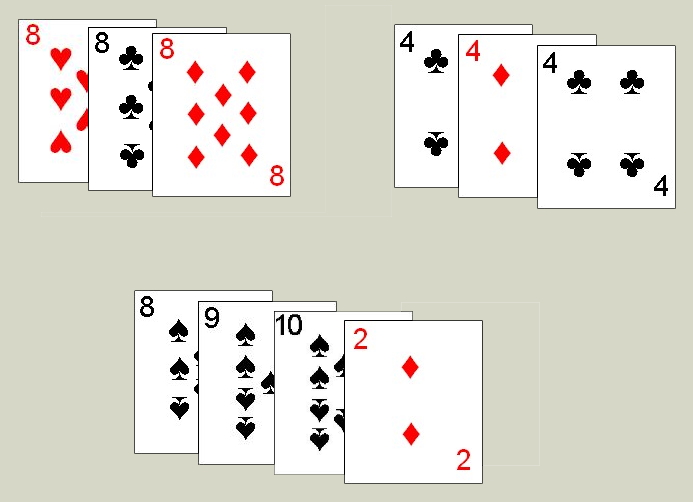
|
In this game, twos are not considered wild cards, but Jokers are. Although a run may contain more than one Joker, any Jokers found in the run must not be directly adjacent. In other words, there can never be two wild cards in direct sequential order in any run.
On his turn, if a player has already played his required meld to the table, he may replace a Joker found on the board with the actual card the Joker was intended to replace. A player must do this on his turn, and must play the Joker on that same turn. In addition, a player may only make this replacement for wild cards played by the other players.
In all other aspects this game is played identically to Frustration Rummy as described directly above.
Garbage Rummy: The cats encountered this game some years ago but never afterwards found published rules for the game. After a thorough search, a few listings were found, so it seems although Garbage Rummy is a rare game, it is still played. It is a great variation of Rummy, featuring the differing contacts through a variable number of hands.
As in other, similar games, Garbage rummy has a number of separate contracts in which a player must complete before winning. However, as opposed to standard Contract Rummy, each player may be striving for a different such contract depending on how may previous meld contracts they have previously fulfilled. This game uses two standard 52 card decks shuffled together plus four Jokers. The traditional ranking of the card denominations is used in this game as follows (from high to low); Ace, King, Queen, Jack, 10, 9, 8, 7, 6, 5, 4, 3, 2, Ace. As can be noticed from this ranking an Ace can either be used at the top of a sequence or at the bottom, but no around the corner runs are permitted (i.e. A run of Ace, 2, 3 or Queen, King, Ace is allowed but a run of King, Ace, 2 is not).
After determination of first dealer and seating positions, the dealer will then begin the deal. In a feature borrowed from other games such as six pack Bezique, the dealer attempts to pull off the exact number of cards from the stock as required for the deal. This would equate to 10 cards for each player plus 1 extra dealt to the first player. If the dealer is able to do this, he instantly is able to reduce his current score by 50 points.
The dealer would then deal the cards in a clockwise rotation. All participants would receive 10 face down cards except the player to the immediate left of the dealer who receives a total of 11. He then places the stock in the center of the table and play begins.
The first player to the immediate left of the dealer takes the first turn. Since he was dealt one extra card, his turn consists of melding (if able) and then discarding any card from his hand.
After this first player takes his turn, each subsequent turn during the hand consists of a player drawing a card (either the exposed top card of the discard pile or the top card of the draw pile), melding if able and then discarding one card to the discard pile.
The final goal of each player is to complete all 11 of the following meld requirements over the course of a series of hands. The first player to have achieved each goal, in order, in a separate hand is declared the game winner. The following chart shows the entire list of goals a player must complete:
| Order | Meld Requirement |
|---|
| 1 | 2 sets of 3 cards each |
| 2 | 2 runs of 3 cards each |
| 3 | 1 set of 3 cards, 1 run of 4 cards |
| 4 | 2 sets of 4 cards each |
| 5 | 1 set of 3 cards, 1 run of 5 cards |
| 6 | 3 sets of 3 cards each |
| 7 | 1 run of 7 cards |
| 8 | 1 set of 3 cards, 1 run of 6 cards |
| 9 | 2 runs of 4 cards each |
| 10 | 2 sets of 5 cards each |
| 11 | 1 run of 11 cards |
The four Jokers are considered wild cards and can be used as a replacement for any other card of the players choosing. If a player later during the hand obtains the actual card the Joker represents in their exposed meld, they may substitute the card during their turn and use the Joker to extend or create a new meld.
 |
The game ends at such time as one player manages to complete all 11 meld requirements. This player subtracts 100 points from his score for the feat. All the scores are then calculated and the player with the lowest score is declared the winner.
When a player completes his goal for the hand, he may then meld the cards making up that goal to the table. After making this meld, he may then create additional melds and lay cards off on melds of other players or his own.
When any player melds or discards the last card in his hand, the hand ends. Each card remaining in the opponents hand is added to that players current score. The values for these cards found remaining in the player's hand are as follows:
| Card | Point Value |
|---|
| 2, 3, 4, 5, 6, 7, 8, 9 | 5 |
| 10, Jack, Queen, King | 10 |
| Ace | 15 |
| Joker | 20 |
If a player was unable to complete his last meld requirement in the last hand, he must again attempt this during the current hand. Once accomplishing a specific meld requirement in a hand (even if he is not the winner of that hand) he can then move to the next requirement in the next hand of play.
A player must actually make the required meld to the table, as cards in the hand but not melded are not regarded as valid melds. A players turn consists of drawing a card, making any melds if willing and able, and then discarding. On his last turn of a hand, instead of discarding, a player may also meld his 11th and last card. In the last contract this is actually required as a full 11 card run is necessary in order to fulfill a players 11th and final meld.
Copyright © 2015 CatsAtCards.com. All rights reserved.
 The standard game Frustration is designed to be played by 2 to 5 players, but variants for more players are
described below. The game uses two standard 52 card decks shuffled together. For the best play experience the decks should be of the same back design, but this is not absolutely essential. The sequential ranking of the cards in this game are as follows, from high to low; Ace, King, Queen, Jack, 10, 9, 8, 7, 6, 5, 4, 3. All two's are wild cards and can be used as a replacement for any other card in creating a meld.
The standard game Frustration is designed to be played by 2 to 5 players, but variants for more players are
described below. The game uses two standard 52 card decks shuffled together. For the best play experience the decks should be of the same back design, but this is not absolutely essential. The sequential ranking of the cards in this game are as follows, from high to low; Ace, King, Queen, Jack, 10, 9, 8, 7, 6, 5, 4, 3. All two's are wild cards and can be used as a replacement for any other card in creating a meld.




